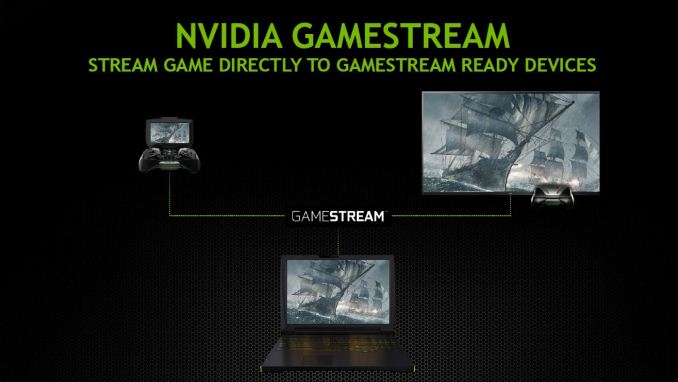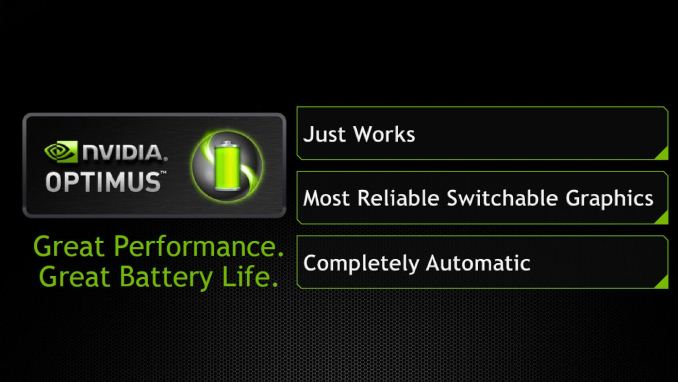NVIDIA’s GeForce 800M Lineup for Laptops and Battery Boost
by Jarred Walton on March 12, 2014 12:00 PM ESTOther Features: GameStream, ShadowPlay, Optimus, etc.
Along with Battery Boost, the GTX class of 800M GPUs will now also support NVIDIA’s GameStream and ShadowPlay technologies, again through NVIDIA’s GeForce Experience software. Unlike Battery Boost, these are almost purely software driven solutions and so they are not strictly limited to 800M hardware. However, the performance requirements are high enough that NVIDIA is limiting their use to GTX GPUs, and all GTX 700M and 800M parts will support the feature, along with the GTX 680M, 675MX, and 670MX. Basically, all GTX Kepler and Maxwell parts will support GameStream and ShadowPlay; the requirement for Kepler/Maxwell incidentally comes because GameStream and ShadowPlay both make use of NVIDIA’s hardware encoding feature.
If you haven’t been following NVIDIA’s software updates, the quick summary is that GameStream allows the streaming of games from your laptop/desktop to an NVIDIA SHIELD device. Not all games are fully supported/optimized, but there are over 50 officially supported games and most Steam games should work via Steam’s Big Picture mode. I haven’t really played with GameStream yet, so I’m not in a position to say much more on the subject right now, but if you don’t mind playing with a gamepad it’s another option for going mobile – within the confines of your home – and can give you much longer unplugged time. GameStream does require a good WiFi connection (at least 300Mbps 5GHz, though you can try it with slower connections I believe), and the list of GameStream-Ready routers can be found online.
On a related note, something I'd really like to see is support for GameStream extended to more than just SHIELD devices. NVIDIA is already able to stream 1080p content in this fashion, and while it might not match the experience of a GTX 880M notebook running natively, it would certainly be a big step up from lower-end GPUs and iGPUs. Considering the majority of work is done on the source side (rendering and encoding a game) and the target device only has to decode a video stream and provide user I/O, it shouldn't be all that difficult. Take it a step further and we could have something akin to the GRID Gaming Beta coupled with a gaming service (Steam, anyone?) and you could potentially get five or six hours of "real" gaming on any supported laptop! Naturally, NVIDIA is in the business of selling GPUs and I don't see them releasing GameStream for non-NVIDIA GPUs (i.e. Intel iGPUs) any time soon, if ever. Still, it's a cool thought and perhaps someone else can accomplish this. (And yes, I know there are already services that are trying to do cloud gaming, but they have various drawbacks; being able to do my own "local cloud gaming" would definitely be cool.)
ShadowPlay targets a slightly different task, namely that of capturing your best gaming moments. When enabled in GFE, at any point in time you can press Alt+F10 to save up to the last 20 minutes (user configurable within GFE) of game play. Manual recording is also supported, with Alt+F9 used to start/stop recording and a duration limited only by the amount of disk space you have available. (Both hotkeys are customizable as well.) The impact on performance with ShadowPlay is typically around 5%, and at most around 10%, with a maximum resolution of up to 1080p (higher resolutions will be automatically scaled down to 1080p).
We’ve mentioned GeForce Experience quite a few times now, and NVIDIA is particularly proud of all the useful features they’ve managed to add to GFE since it first went into open beta at the start of 2013. Initially GFE’s main draw was the ability to apply “optimal” settings to all supported/detected games, but obviously that’s no longer the only reason to use the software. Anyway, I’m not usually much of a fan of “automagic” game settings, but GFE does tend to provide appropriate defaults, and you can always adjust any settings that you don’t agree with. AMD is trying to provide a similar feature via their Raptr gaming service, but by using a GPU farm to automatically test and generate settings for all of their GPUs NVIDIA is definitely ahead for the time being.
NVIDIA being ahead of AMD applies to other areas as well, to varying degrees. Optimus has seen broad support for nearly every laptop equipped with an NVIDIA GPU for a couple years now, and the number of edge cases where Optimus doesn’t work quite as expected is quite small – I can’t remember the last time I had any problems with the feature. Enduro tends to work okay on the latest platforms as well, but honestly I haven’t received a new Enduro-enabled laptop since about a year ago, and there have been plenty of times where Enduro – and AMD’s drivers – have been more than a little frustrating. PhysX and 3D Vision also tend to get used/supported more than the competing solutions, but I’d rate those as being less important in general.













91 Comments
View All Comments
JarredWalton - Wednesday, March 12, 2014 - link
They did drop the "GT" on the 840M/830M/820M.JarredWalton - Wednesday, March 12, 2014 - link
And adding to that, keeping GTX allows them the ability to say, "GTX is required for Battery Boost, GameStream, and ShadowPlay."jeffbui - Wednesday, March 12, 2014 - link
Is there a reason why the GPUs have been stuck at the 28nm node for so long? IIRC the 600 series was also a 28nm part.TheinsanegamerN - Wednesday, March 12, 2014 - link
simple. TSMC's 20nm process STILL isnt ready for mass use. until they are finished, both AMD and NVIDIA are stuck at 28nm. it's too bad, as laptop GPUs are screaming for 20nm gpus.Guspaz - Wednesday, March 12, 2014 - link
GeForce Experience is pretty awesome. It used to be that whenever I got a new game, I'd have to spend a lot of time trying to figure out the right settings for it; the default settings would usually either run way too slow or way too fast. But with GeForce experience, they've already tested the game with the same CPU and GPU that I've got, and its defaults are generally a good balance of quality and performance. So what used to be an involved process of play-tweak-play-tweak-play is now just a "mash button and go".That said, it could still use some polish. I don't know if it's still in beta, but it feels like it. It's not uncommon for it to start reporting "game cannot be optimized" for games that it DOES support (and that you have previously optimized), which usually requires a reboot. And a few months ago nVidia did a self-update that caused it to go completely nuts, locking up the machine (a trip to their forums indicated it happened to everybody who got the update before they fixed it).
Concillian - Wednesday, March 12, 2014 - link
"Where things get a little interesting is when we get to the GTX 860M. As we’ve seen in the past, NVIDIA will have two different models of the 860M available, and they’re really not very similar (though performance will probably be pretty close)."no... performance won't be close. This is a laptop, where power efficiency is part of performance, and you me, and the author all know power consumption of the "Maxwell 860M" is going to be less than the "Kepler 860M" the article should be absolutely SLAMMING nVidia for calling two very different parts the same thing. The video card numbering schemes are confusing enough to laymen (I get asked to try to explain it regularly, since I'm the go to hardware guy in my circle of friends, relatives, co-workers, casual acquaintances and all their friends...) It's going to be impossible to tell them that it depends on which GTX860 they get and they probably can't tell which they'll get until they get the computer...
JarredWalton - Wednesday, March 12, 2014 - link
We've complained many times about overlapping names in the past. There were for instance two completely different versions of the GT 555M (which later became the GT 635M I believe). And performance and battery life are not "the same" -- particularly since the GPU is usually off when you're on battery power. If you want to play games while unplugged, well, there it could be a different story. Anyway, we pointed it out, said it was a dumb overlap more or less (the "interesting" was meant as a sarcastic interesting, not a "wow, this is really interesting"; perhaps that wasn't properly conveyed though I'd suggest the rest of the text supports that), and moved on. If the Kepler variant is widely used, we'll certainly complain about it.Runamok81 - Wednesday, March 12, 2014 - link
Best news here? nVidia finally dropped the silly GTX suffix. Bump that stock price. Sanity is prevailing.Death666Angel - Wednesday, March 12, 2014 - link
Nope.Anders CT - Wednesday, March 12, 2014 - link
GTX 860M and GTX 860M are two different GPU's using different architectures?That is a pretty lame naming scheme.